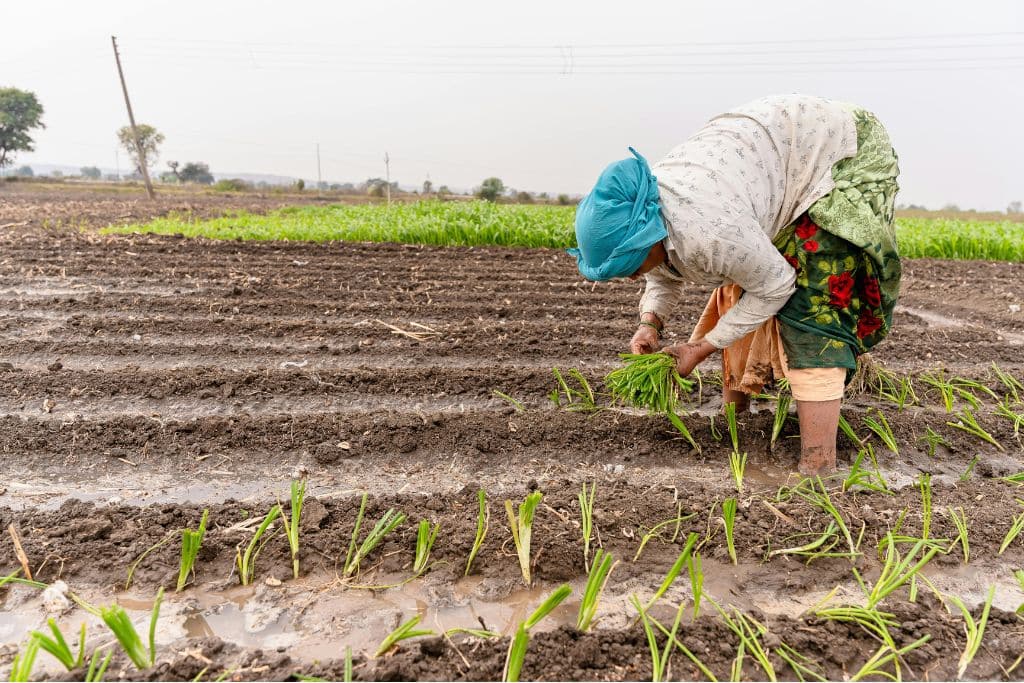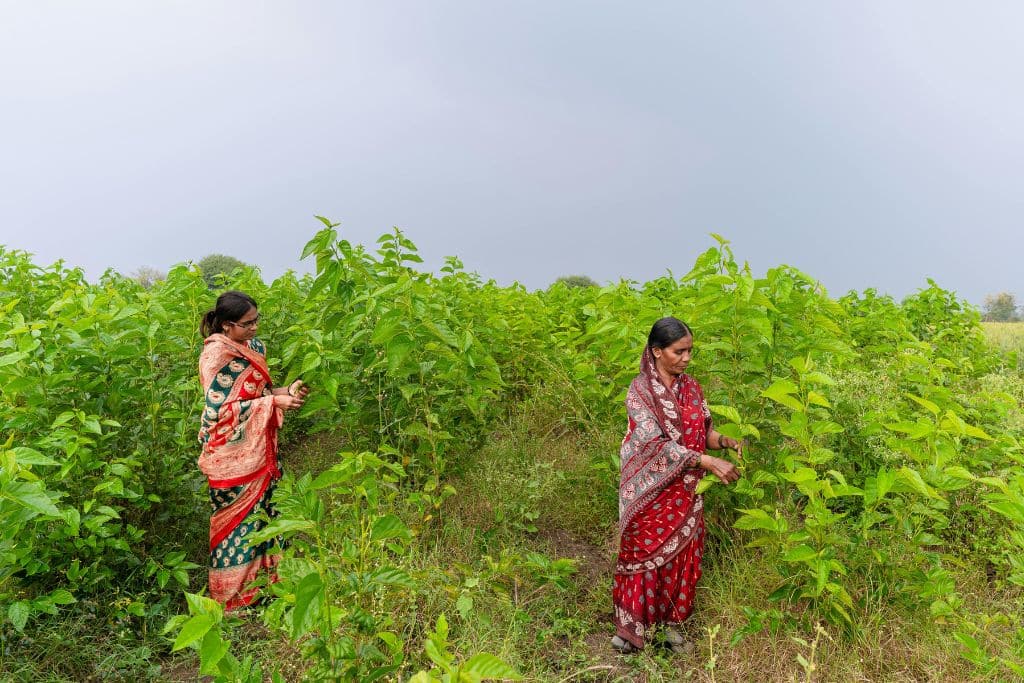Smallholder farmers provide a third of the world’s food, yet they are often exploited by middlemen. In India, the Save Soil Regenerative Agriculture Programme is engineering a new system to help farmers transition to regenerative farming, while connecting them with local businesses and consumers.
—
As a farmer myself, I understand the struggles of smallholder farming first-hand. For the 570 million smallholder farmers worldwide, profits are becoming increasingly precarious. Between increasingly erratic weather patterns, water stress and soil erosion, a solid harvest is no longer inevitable.
That has to change. Today, many farmers have no choice but to borrow from tomorrow’s harvests to provide food today. This is because the middlemen, and the markets who drive them, favor bulk produce. But bulk produce demands intensive, fertilizer-heavy mono-crop farming practices. Practices that do not just erode our soils, but also the stability of our future food systems.
Soil health has implications for everyone, not just for farmers. Fortunately, we can replenish soil health by making regenerative farming the profitable option for farmers. In the process, we can also replenish human health by making organic produce affordable for the global middle class.
To accelerate the transition to regenerative farming, we have to build a fairer, healthier, more accessible market. By allowing farmers to sell directly to consumers, we create a virtuous cycle; we can increase profit for the seller while reducing the price for the buyer.
At the Save Soil Regenerative Agriculture Programme in India, we are building a new type of market for organic, regeneratively-grown food. What we are building in India could be used as a blueprint for scaling regenerative agriculture markets across the world.
Ultimately, pivoting to regenerative practices is more profitable for the farmer in the long run. It reduces the need to invest in heavy tillage machinery, pesticides, and fertilizers.

Regardless of their profitability, farmers making the transition to regenerative practices face many hurdles.
The first is education. Practices like crop rotation, agroforestry, and bio-input preparation need to be taught. Along with in-person training, we have set up a hotline where farmers can call for instant advice on how to pivot to regenerative farming.
The next is market access. Traditionally, small farmers rely heavily on middlemen. These middlemen often have an unfair advantage over farmers. Middlemen often have monopolies on supply chains and better access to accurate market price information. This enables them to manipulate prices, which further cuts into what are already razor-thin margins. This trend is not unique to India; it has been reported everywhere from Nigeria to the United States.
Our model addresses this by enabling farmers to sell directly to consumers, allowing them to retain a greater portion of their earnings. By reducing reliance on middlemen, farmers are incentivized to adopt regenerative practices as they know they can get a fair price.
Of course, regenerative farming and organic produce remain a fringe phenomenon at the country level, so eliminating middlemen entirely may not be feasible. However, by selling a greater share of produce to local communities, restaurants and businesses, we can allow farmers to diversify their clients, therefore reducing reliance on the exploitative practices of middlemen.
This model not only allows farmers to sell produce at a fair price. It grants local people access to organic food that would otherwise be far more expensive in supermarkets.
Currently, our pilot phase in Coimbatore involves approximately 100 regenerative farmers supplying produce directly to the Isha Yoga Center. This center provides daily natural food to around 4,000 residents, demonstrating a sustainable market. Farmers receive a 10-15% premium above conventional market prices.
This model is scalable, as demonstrated by our progress across Tamil Nadu. Approximately 9,000 farmers have already transitioned to regenerative methods. We are also developing a digital platform and a network of WhatsApp groups to connect regenerative farmers to consumers, restaurants, and institutions.
Another hurdle comes in the form of certification. High-premium organic produce requires a form of third-party certification, a process typically too costly and complicated for small-scale farmers. Instead, our model leverages the trust of local people with the farmers in their own community. This approach allows farmers to obtain premium prices without the significant burden of formal certification, therefore streamlining their path to market.
Despite our initial success, notable challenges remain. These include digital literacy gaps among rural farmers, logistical complexities in distribution, and resistance from entrenched market interests that benefit from the existing agricultural systems.
Our structured support system helps farmers overcome these hurdles.
What sets this initiative apart is its emphasis on grassroots empowerment. While boosting soil health remains crucial, this program is about far more than that. It is about revitalizing rural economies, boosting human health and, ultimately, creating a sustainable market for naturally grown food.
We are also proving the widely popularized claim that regenerative agriculture cannot feed an entire nation to be untrue. The farmers enrolled in the program are taking yields that match, and often surpass, those taken by conventional farms. Once the government understands this, and provides regenerative farmers with the same level of subsidy support received by conventional farmers, then we can prove that regenerative farming can provide a firm food foundation for India.
Ultimately, creating robust, accessible markets is essential for the widespread adoption of regenerative agriculture. Our experience in Coimbatore and broader Tamil Nadu has proven that with the right support, small-scale farming does not have to be a precarious way to make a living.
84% of the world’s farms are small holdings, and they provide a third of the world’s food. By creating economically attractive conditions for regenerative agriculture, we can foster a sustainable transformation in global farming practices, benefiting farmers, consumers, and the environment alike.
This model, rooted in the success we have seen in Tamil Nadu, could be scaled across the globe. Countries with similar smallholder farming dynamics, like Kenya, Indonesia, and Peru, stand to benefit from a model that combines farmer training, direct-to-consumer sales, and a supportive digital ecosystem.
In East Africa, where erratic rainfall and soil degradation threaten food security, regenerative methods such as agroforestry and composting could restore fertility and stabilize farmer yields. In Southeast Asia, where rice monoculture dominates, diversification through crop rotation and organic practices could provide more resilient soils and incomes. In Latin America, where many rural farmers struggle with market access, platforms that bypass intermediaries can level the playing field and revive local economies. This model can be adapted to local contexts while keeping the core principles of farmer empowerment, market access, and community trust intact.
Ultimately, regenerative farming does not just heal the land. It could deliver a healthier, more equitable food system worldwide. If we are to make regenerative agriculture the global norm, we cannot just focus on the ecological benefits. We need to create a compelling economic case for both farmers and consumers.
This story is funded by readers like you
Our non-profit newsroom provides climate coverage free of charge and advertising. Your one-off or monthly donations play a crucial role in supporting our operations, expanding our reach, and maintaining our editorial independence.
About EO | Mission Statement | Impact & Reach | Write for us








